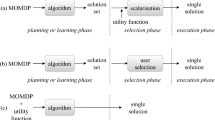Abstract
We present a multi-agent approach to constraint satisfaction where feedback and reinforcement are used in order to avoid local optima and, consequently, to improve the overall solution. Our approach, FeReRA, is based on the fact that an agent’s local best performance does not necessarily contribute to the system’s best performance. Thus, agents may be rewarded for improving the system’s performance and penalised for not contributing towards a better solution. Hence, agents may be forced to choose sub-optimal moves when they reach a specified penalty threshold as a consequence of their lack of contribution towards a better overall solution. This may allow other agents to choose better moves and, therefore, to improve the overall performance of the system. FeReRA is tested against its predecessor, ERA, and a comparative evaluation of both approaches is presented.
Access this chapter
Tax calculation will be finalised at checkout
Purchases are for personal use only
Preview
Unable to display preview. Download preview PDF.
Similar content being viewed by others
References
Agassounon W., Martinoli A. and Goodman R., A scalable distributed algorithm for allocating workers in embedded systems. In: Proceedings of the 2001 IEEE Systems, Man and Cybernetics Conference. October 2001, pp. 3367–3373.
Basham, M.B., Automatic frequency planning for mixed voice and GPRS systems MSc Dissertation, University of Sussex, 2002.
Bonabeau E., Dorigo M., and Theraulaz G., Inspiration for optimization from social insect behaviour Nature, 407, pp. 39–42, July 2000.
Bonabeau E., Henaux F., Guerin S., Snyers D., Kuntz P., Routing in telecommunications networks with “smart” ant-like agents. In: Proceedings of IATA’98, Second International Workshop on Intelligent Agents for Telecommunications Applications. Lecture Notes in AI vol. 1437, Springer Verlag, 1998.
Cicirello V.A. and Smith S. F., Improved routing wasps for distributed factory control. In: IJCAU-0I Workshop on Artificial Intelligence and Manufacturing: New AI Paradigmsfor Manufacturing, August 2001
Fabiunke M., A swarm intelligence approach to constraint satisfaction. In: Proceedings of the Sixth Conference on Integrated Design and Process Technology, June 2002.
Faiunke M. and Kock G., A connectionist method to solve job shop problems. Cybernetics and Systems: An International Journal, 31(5), pp. 491–506, 2000.
Fitzpatrick S. and Meertens L., An experimental assessment of a stochastic anytime, decentralized, soft colourer for sparse graphs. In: Proceedings of the Symposium on Stochastic Algorithms, Foundations and Applications, Springer, Berlin, pp. 49–64, 2000.
Han J., Liu J. and Qingsheng C., From ALIFE agents to a kingdom of n-queens In: J. Liu and N. Zhong eds., Intelligent Agent Technology: Systems, Methodologies, and Tools, pp. 110–120, The World Scientific Publishing Co. Pte, Ltd., 1999.
Lawlor M. and White T., A self organizing social insect model for dynamic frequency allocation in cellular telephone networks. In: Proceedings of the Second International Joint Conference on Autonomous Agents and Multi-agent Systems (AAMAS 2003), to appear.
Liu J., Han J. and Tang Y.Y., Multi-agent oriented constraint satisfaction Artificial Intelligence 136(1) pp. 101–144, 2002.
Swarm Development Group, Swarm simulation system, http://www.swarm.org
Tateson R., Self-organising pattern formation: fruit flies and cell phones. In: Autonomous Agents and Multi-Agent Systems, Vol. 3,No.2, pp. 198–212, 2000.
Voudouris, C, Guided local search for combinatorial optimisation problems, PhD Thesis, Department of Computer Science, University of Essex, Colchester, UK, July, 1997
Wu, Z. and Wah, B. W. Trap escaping strategies in discrete lagrangian methods for solving hard satisfiability and maximum satisfiability problems. In AAAI/IAAI, pp. 673–678, 1999.
Yokoo M. and Hirayama K., Algorithms for Distributed Constraint Satisfaction. In Proceedings of the 2 nd International Conference on Multi agent systems, pp. 401–408, 1996.
Author information
Authors and Affiliations
Editor information
Editors and Affiliations
Rights and permissions
Copyright information
© 2004 Springer-Verlag London
About this paper
Cite this paper
Basharu, M., Ahriz, H., Arana, I. (2004). Escaping Local Optima in Multi-Agent Oriented Constraint Satisfaction. In: Coenen, F., Preece, A., Macintosh, A. (eds) Research and Development in Intelligent Systems XX. SGAI 2003. Springer, London. https://doi.org/10.1007/978-0-85729-412-8_8
Download citation
DOI: https://doi.org/10.1007/978-0-85729-412-8_8
Publisher Name: Springer, London
Print ISBN: 978-1-85233-780-3
Online ISBN: 978-0-85729-412-8
eBook Packages: Springer Book Archive




